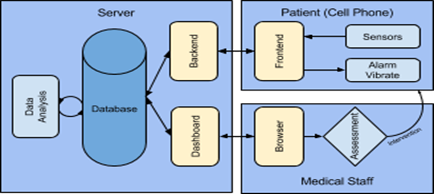Telemedicine: PORTAL PRIVACY PREFERENCES (ACTIVITY MONITORING OF PATIENTS WITH HEART FAILURE)
Lead Institution: UC Berkeley and Northwestern University
Project Leader: R. Bajcsy and D. Liebovitz
Research Progress
-
Abstract
The goal in this project was to respond to President Obama’s call to reduce the cost of health care using information technology while understanding potential privacy implications. Towards that end, we developed a smartphone based system for remote real-time tele-monitoring of physical activity for patients with chronic heart failure exploring the hypothesis that targeted interventions for at-risk patients would reduce their probabilities for hospital admission or of receiving emergency care.First, we developed an Android based application to record in real-time and securely transmit to our servers, estimates of a patient’s energy expenditures based on the patient’s physical activity detected through the smartphone’s accelerometer sensor. In addition, the system was designed to record the patient’s location (when available) for travel distance calculations. To minimize potential privacy concerns, each patient’s location records were shifted by a quantity that is unknown to the medical staff so that recorded locations of the patients were protected. In order to make more objective assessments of the patients’ activity levels, we designed several mechanisms to ensure that we distinguished any technical failures from measured signals. For example, the cell phone position (for example, whether the phone is measuring body movements or left on the table), and dealing with the lack of wireless coverage in order to not lose data as well as iterative efforts to minimize battery consumption.

Figure 1. System architecture.
Second, we designed a brief daily survey that was delivered to patients through the smartphone application. The survey inquires about vital signs (heartbeat rate, blood pressure and weight), and medical symptoms (fatigue, shortness of breath, dizziness, etc.). In addition, the survey includes occasional privacy intrusive questions that were designed to study the privacy boundaries of tele-monitoring in health settings. Finally, we designed a scoring algorithm that aimed to assess the overall medical status of the monitored patients based on their answers to the daily survey. The output of the algorithm is a single score that if exceeded a certain threshold, would trigger medical intervention by our cardiology staff. The system also encouraged patients to contact their physician in case of high-risk scores. The interactions during medical interventions were recorded in the patients’ medical charts, and are now pending analysis.

Figure 2. System Dashboard.
Although the tele-monitoring system was designed for tracking individuals with chronic heart-failure, the challenges, privacy considerations and lessons learned apply to other conditions that would benefit from continuous or periodic monitoring through mobile-health technologies, such as asthma, diabetes and hypertension.
-
Focus of the research/Market need for this project
The system we developed is based on the widely available Android operating system. Our smartphone application is open source. While a range of off-the-shelf products for energy expenditure estimates data collection is available, such as Nike+FuelBand, FitBit’s Activity Wristbands and Trackers, they are proprietary and unproven in medical contexts. Furthermore, it is not clear that these off-the-shelf technologies guard against faulty data (equivalent to the described problem of the phone positioning above), which may generate false measures of movement, nor is it clear that they have safeguards in place to respect the privacy of the patients. -
Project Aims/Goals
Our main goal was to develop a simple, cost effective, easy to use, privacy respecting tele-monitoring system based on a smartphone that provides continuous and real-time estimates of energy expenditure and incorporates daily self-reported vital signs and cardiovascular symptoms of patients with chronic heart-failure.Furthermore, our aim was to test the system with real patients in their homes. We were especially eager to learn how reliable the monitoring will be considering the population of chronic heart failures which includes varied ages and socio-economic stat
. -
Key Conclusions
We successfully monitored 15 patients with heart-failure (some patients are still being monitored) and performed medical interventions on several occasions.
In comparison to the costly emergency room visits, the developed technology appears cost effective (cell phone price was under $200). We incorporated valuable lessons from iterative interface design so that a technically unsophisticated user can use the system.Health provider engagement is a critical component of the system and his/her cost has to be considered though it remains substantially less than if a patient has to be readmitted to the hospital or experiences an emergency room visit.
Limitations include ensuring adequate cellular coverage, an important consideration for patients who may live or travel to areas with poor coverage.
Privacy, usability and acceptability analyses are pending final study data collection. -
Materials Available for Other Investigators
All our software is open source.
Bibliography
Continuous, Real-Time, Tele-monitoring of Patients with Chronic Heart-Failure: System Overview
Daniel Aranki, Gregorij Kurillo, Posu Yan, David Liebovitz, and Ruzena Bajcsy
The 11th International Conference on Wearable and Implementable Body Sensor Networks, 2014
Continuous, Real-Time, Tele-monitoring of Patients with Chronic Heart-Failure: Pilot Study
The 9th International Conference on Body Area Networks, 2014
